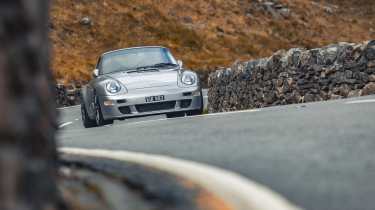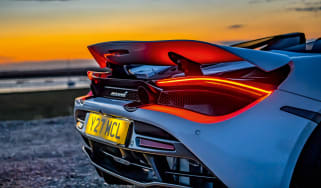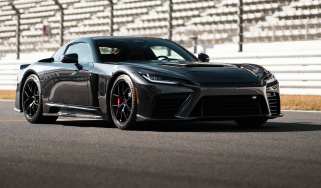Autoart 993R 2022 review – Porsche 911 restomod to compete with the very best
Porsche specialist melds classic design with modern technology resulting in a restomod classic that’s as competitive as today’s greats
Backdated restomod Porsche 911s are nothing new. There are weeks when you feel you can’t move for another announcement of someone reimagining Ferry Porsche’s idea of a sportscar. So apologies if you’ve had your fill of them, but please don’t click away just yet, because while the Autoart 993 R has a resto-backdate vibe to it, I heartily recommend you hang around for the engine.
A project born from the imagination of a customer of Paul Stephens Porsche, the Essex-based specialist that has bought, sold, modified and, yes, backdated 911s of all flavours and eras for the last two-plus decades. The 993R was a very specific project. “We wanted to build a light, fast 911 for the road,” explains Stephens. “Reducing weight was more important than chasing performance, because if you do the latter right the former comes for free.”
If you didn’t see last week’s announcement when the car was revealed, a brief summary goes like this. Starting with a 993 Carrera 2 manual, the whole car is stripped back to its shell, which is then seam welded to increase stiffness by a considerable margin (Stephens has yet to measure the improvement) with a half-cage added across the rear seat area (there’s still room to store luggage in new bespoke ‘seats’ .
From here the rain gutters are removed from the roof, so too the sunroof, bumpers, mirrors and anything else Porsche fitted at the factory 30 years ago. And then it’s rebuilt using as few components as necessary that are also as light as practically possible. “The wiring look took quite a hit, we even went as far as removing the courtesy lights in the roof so we didn’t have to run wire up the A-pillars.” They also ditched the central locking, electric windows and mirrors, replaced the air-con system with a lighter one, didn’t bother to refit the radio and even went as far as removing the after-thought controls and switches Porsche threw at the 993’s instrument binnacle when it started to fit rear window wipers. And there’s no glovebox lid or central transmission tunnel.
More reviews
In-depth reviews
- Porsche 911 Carrera GTS T-Hybrid review – the first hybrid 911 is one of the best
- Used Porsche 911 (991, 2011 - 2018) review – should you buy the unloved 911?
Long term tests
Reviews
- New Porsche 911 Turbo S review – McLaren Artura performance with four seats
- RML GT Hypercar review – the Porsche 911 taken to the ultimate extreme
- Used Porsche 911 (997, 2004 - 2012) – the ultimate sweet spot 911
- Porsche 911 Turbo S (992.1, 2020 - 2024) review – Stuttgart’s supercar slayer
- Porsche 911 3.2 Carrera (1984 - 1989) review – flawed but furiously charming
> Porsche 911 reimagined by Singer review
Thinner glass from the Porsche Motorsport department, lighter carpet and sound deadening are utilised too, and the 993’s heavy interior panels have been replaced with lighter replicas that also bring the additional benefit of reducing the panel gaps from Grand Canyon sized to one you’d struggle to slide a Rizla paper into.
All in the 993R tips the scales 1220kg wet, 150kg lighter than the donor car, and a potent ally when you take into account what’s powering the R. It’s air-cooled, naturally, but capacity has increased 200cc to 3.8-litres and the innards of the flat-six are either sourced from Porsche’s Motorsport department (997 GT3 crank, bearings and oil pump, RSR pistons), or specialists such as Paulter who have supplied the con-rods, Jenvey the throttle bodies with the cams bespoke to Stephens’s spec.
It all breathes through a reworked induction system and out through a Cargraphic exhaust resulting in, not only a soundtrack to scare every last hair on your body to attention, but an engine with such reach, it’s impossible to not drive it for the sake of it and with a grin as wide the biggest idiot’s.
From low revs it pulls with a precise crispness, every throttle pedal movement resulting in an instant, clean response from over your shoulder. It’s not trigger happy, it’s simply free of any slack throughout the acceleration process. Deciding not to chase a headline grabbing top end power figure and settling on 330bhp at 7400rpm (a more potent 360bhp at a higher 8300rpm redline is possible) has allowed for an engine map that’s tractable from around 1500rpm through to its 7600rpm redline, with flat-spots and any torque and/or power plateaus across the rev range mapped out.
It makes for an addictive and immersive experience, your appetite to hang on to revs becoming insatiable with every mile you cover. The six-speed manual gearbox is your triple platinum pass to unlock it all. For most UK roads you could leave it in third and roll along at an absorbing pace, but then you’ll be missing out on those upshifts that deliver a thumping surge and the opportunity to master downshifts where your feet are as busy as your arms. It’s not dissimilar to the driving experience the very best hot hatches (Civic Type R, Fiesta ST, GR Yaris) deliver due to their size, weight and performance not only perfectly matched to the size and condition of today’s roads, but also that their DNA is one that responds to being worked harder than a sheep dog in a field full of belligerent soon to be roast dinners and wool jumpers.
Unlike the hot hatches, however, there’s a purer chassis beneath you. A huge amount of time and effort went into establishing the right balance from the Tractive adjustable dampers, Stephens’s spending a week with Centre of Gravity to sign off the five different modes selected via the rotary control fitted near the base of the A-pillar.
The result is a ride quality that allows you to exploit that magnificent engine to its full without feeling you are on the verge of being bounced into the next county. It corners with an immediacy, but without immediately taking you to the edge of what the chassis has to offer. It feels instinctive in how it reacts, whether you are gaining momentum on a poorly cambered road or pitching into a favourite corner, relishing in a very trad-911 nose that feels like it wants to push on before instantly hooking up and pulling you through the corner. Your hips take up the centre point and rotate as one with the car, the rear gliding instinctively as it follows the chosen trajectory ready to take a torque load and drive you through the apex. At times it feels more Cayman GT4 than a 911 in how it moves around on the road, the fluidity matched to a natural rhythm.
A Wave-trac diff and 18-inch Michelin Pilot Sport 4S tyres provide the grip and control, the balance perfectly matched to the grip on offer (certainly in the 40-degree heat we tested the car in). Yet it feels adjustable rather than locked down and resolute, suggesting a willingness to move around when required rather than leave you hanging out to dry.
Stephens and his client set out to take the best 993 Carrera and improve on it by 25 per cent. On this first taste it’s hard not to conclude they have done just that. And while many will bulk at the cost (a good 993 Carrera 2 will cost £70,000 and you’ll need at least double that again to achieve the results here, which gets very close to 993 Carrera RS territory) and say you should just buy the newest GT3 you can, which would be perfectly acceptable in our book, would be missing the point of projects such as this. This is a car for those that sweat the detail, and appreciate the minutiae that only restomods and backdates can offer.







